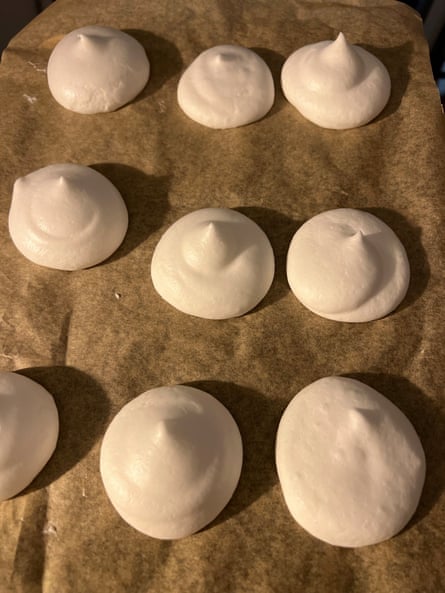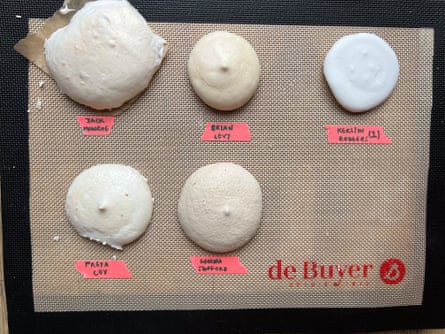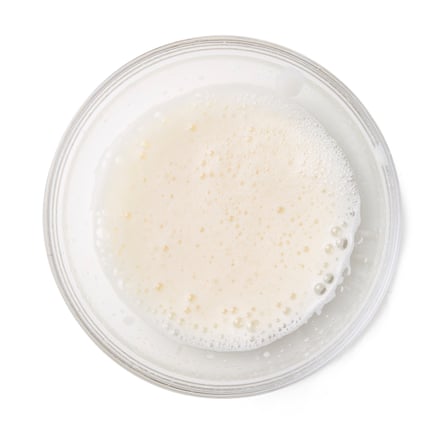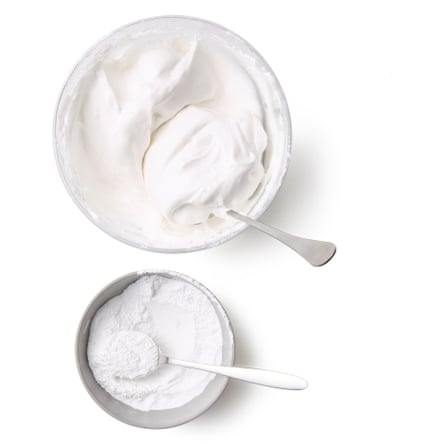From theguardian.com
By Felicity Cloake
Aquafaba comes to the rescue again as the egg substitute in these very convincing vegan meringues
The egg is an everyday miracle – so basic, so cheap, so reliably astonishing in its protean ability to morph from rich custard to airy mousse – and its removal from the equation leaves a gaping culinary hole. And, though plant-based fats are pretty easy to find, for a long time recreating the sturdy foam of whisked egg whites in particular was a challenge that had chefs, scientists and hungry vegans scratching their heads. According to Sébastien Kardinal and Laura Veganpower, despite experimentation with flaxseed, soy protein and CO2 canisters, no one managed to “find a vegan alternative to the soft peaks of whisked egg whites, that held firm in both its raw and cooked forms”.
Then, a decade ago, Joël Roessel, a vegan food blogger, discovered the miracle of aquafaba, or bean water (you can see why the Latin name took off). Unlikely as it may sound, legume cooking water can be whipped into billowing, featherlight foams without any help from a hen. But is this much-hyped ingredient all it’s cracked up to be?
The egg replacement
Despite the excitement in the vegan community, aquafaba is not the only game in town. Kerstin Rodgers, author of V is for Vegan, is a fan of egg replacers, writing that she was “amazed” to discover how well they work. The brand I buy is a dry mix of potato and tapioca starches, raising agents, acidity regulators, stabilisers and methyl cellulose, which thickens to a dense cream when whisked with cold water, though, as with all the egg substitutes, it takes much longer to get to the soft peak stage than egg whites would. A plant-based diet requires a lot of patience, it seems – and far more than I have on my first attempt, when I clearly don’t get enough air into them, because the meringues come out of the oven as sad, flat little foam pancakes. A second go is much more successful, yielding crisp, white meringues with a slightly papery mouthfeel that reminds me a little of communion wafers. I then check its publication date, and realise that Rodgers’ book preceded the aquafaba revolution; indeed, on her website, she concedes its superiority for this purpose.

Kerstin Rodgers’ vegan meringues use egg-replacers instead of aquafaba, and it takes two goes to get them right. Photograph: Felicity Cloake /The Guardian
Egg replacers seem to rely on the thickening powers of starch, while aquafaba, like egg whites, is all about the protein. As author and molecular biologist Nik Sharma explains on Serious Eats, this murky, brown liquid is “rich with substances that enhance water’s foaming abilities, because legume seeds like chickpeas and soya beans contain albumins and globulins, the same proteins found in eggs that make them so useful in creating culinary foams. They’re also rich in saponins, plant-derived organic chemicals that act like soaps in that they can dissolve in both fat and water, and they, too, can help to form stable foams. The combined presence of albumins, globulins and saponins in chickpea cooking liquid means that, when agitated, it will produce a stable foam.”
With far fewer ingredients (water and chickpea extracts, so make sure you don’t buy chickpeas with added salt), aquafaba lacks the slightly powdery mouthfeel of the rehydrated egg replacer, and has a blander, less bitter flavour. I try three recipes using handy cartons bought from my local “health and wellbeing store”: one, from pastry chef and author Brian Levy, who conducted a deep dive into the world of aquafaba meringues for fellow pastry chef and author Nicola Lamb’s KitchenProjects Substack; one from the Great British Bake Off’s first vegan contestant Freya Cox’s book Simply Vegan Baking; and one from chef and author Gemma Stafford’s Bigger Bolder Baking blog.
Though most people seem to find chickpeas have the subtlest flavour of all the legumes, cook and food writer Jack Monroe disagrees, writing in her book Vegan(ish) that she “just couldn’t shake the background taste of chickpeas, and I didn’t like them at all, unfortunately. So I set about trying to make them with a different aquafaba; and cannellini trumped them all by miles.” I’m afraid, however, that I feel the same about the beans: although her “beanjuice meringues” do indeed work, they have a distinct baked-bean aftertaste that I find a little off-putting. If white beans are all you’ve got, then I’d advise adding another flavour to the mix, or serving them with something else – fruit compote, chocolate sauce or similar – as a distraction. (Alternatively, you may, like Monroe, prefer the flavour, in which case knock yourselves out with the cannellini; they’re a penny a tin cheaper than chickpeas at my local supermarket.)

The proof is in the pudding: here’s evidence, if it were needed, that Felicity really has tried all those recipes …
Acids and stabilisers
It’s common to add acid to egg whites before beating to denature some of the proteins and help them bond with the water in the egg and the air you’re whisking into them. Stafford and Cox both use cream of tartar, Kardinal and Veganpower and Jack Monroe both use lemon juice and Rose Prince red-wine vinegar, while Levy doesn’t bother with anything, and it turns out his meringues are so good that they convince me an acid isn’t strictly necessary. Sharma, however, reports that, in his experiments, cream of tartar yields “the most consistently good and reproducible results. Not only does the low pH from the acid help reduce the brown colour developed by the caramelisation and the Maillard reactions, it also helps modify the proteins’ structures to create a stable foam that aerates very well and holds its shape both at room temperature and after baking”, plus, “the baked meringues made with cream of tartar were often much smoother in appearance than the ones that contained none”. The flip side, of course, is that acids have a flavour of their own, which emphasises the natural tanginess of the aquafaba itself. If you’re not going to use the meringues immediately, it might be a good idea to add some cream of tartar. If you don’t have any handy, however, don’t worry unduly.
Unless you’re operating in a very humid environment, you shouldn’t need a starch to soak up excess moisture (Stafford, for example, uses cornflour and Monroe arrowroot) – aquafaba meringues will go soft more quickly than the classic variety, but adding starch doesn’t seem to help counter this.

Cox and Monroe both use xanthan gum in their recipes, which doesn’t sound like a domestic ingredient, but is in fact easily found in supermarkets these days. It has a remarkable effect on the texture of the meringue, turning it almost sculptural, and is useful if you want to create a precise shape (Cox’s meringues spread the least of all the ones I try, keeping their shape right up to the crisp little nipple on top) but, again, it’s definitely not necessary for good results.
The sugar
Caster sugar is the most common choice, because the smaller grains dissolve more easily than the coarser ones in Stafford’s granulated version, though it’s not unusual to use a mixture of icing and caster sugar, as Monroe and Levy suggest, the former for structure, the latter for a smoother texture. Again, you can use just caster, if you prefer (or, like Rodgers, icing sugar alone, though the meringues won’t whip up quite as well as they do with caster).
The more sugar of any sort you put in, the firmer and more stable the resulting meringue will be – recipes with roughly equal amounts of sugar and aquafaba, such as Cox’s and the one in the Mildreds Vegan Cookbook, are more delicate, while Levy’s, which has a ratio of 2:1, is sturdier and crunchier, which I prefer. These are never going to be a health food, after all. As with all meringues, add the sugar only gradually, so it doesn’t undo all the hard work you (or your mixer) has done whipping air into the meringue – if you tip in all the sugar at once, the meringue will take ages to regain its former volume.
The flavourings
Vanilla is the classic choice, but I love Rodgers’ rosewater and Sharma’s ground cardamom, and no doubt other flavourings would work equally well.
The oven
A low oven is required for meringues. That’s because you’re drying them out as much as cooking them, so keeping the heat down helps avoid either caramelisation or cracking. Again, patience is a virtue here; Monroe’s are still gooey after 80 minutes, which may be what you’re after, but for a firm result, I’d err towards Stafford’s two hours. Depending on how crumbly you like your meringues, you may want to leave them to cool in the oven, as Cox suggests.
Once the meringues are cool, consume with indecent haste or store in an airtight box – vegan meringues go soft fairly quickly, but they’ll still be delicious.
Perfect vegan meringues
Prep 10 min
Cook 2 hr 20 min
Makes About 25
100g aquafaba, either strained from a tin of chickpeas or bought separately
¼ tsp cream of tartar (optional)
100g caster sugar
A pinch of salt (optional)
½ tsp vanilla extract, or other flavouring (optional)
100g icing sugar, sifted to get rid of lumps
Heat the oven to 110C (90C fan)/230F/gas ¼. Line two oven sheets with baking paper or a reusable baking mat, and get ready a piping bag with a roughly 1⅓cm nozzle, if you have one.
Pour the aquafaba into the bowl of a stand mixer, or a large, scrupulously clean glass or ceramic bowl anchored to a work surface with a damp cloth or similar.

Begin to whisk on a medium-high speed until foamy, add the cream of tartar, if using and whisk to firm peaks (depending on the make of your stand mixer, you might need to get in there with a hand mixer at the beginning, because liquid can get trapped in the bottom in some models when working with relatively small volumes).
Reduce the speed slightly and very gradually add the caster sugar spoonful by spoonful, giving each addition time to be absorbed before adding the next. Add a pinch of salt and the vanilla extract or other flavouring, if using.

Turn up the speed again and whisk until the mixture forms firm, glossy peaks and is stiff enough for you to tip the bowl without it moving (this will take longer than it does with egg whites), then use a large metal spoon to fold in the sifted icing sugar a third at a time, being careful to keep as much of the air in the mix as possible.

Transfer the meringue mix to the piping bag (or similar), then pipe or spoon on to the lined trays in roughly 5cm rounds spaced slightly apart (or make shapes of your choice).

Bake for about two hours, by which point the meringues should be completely dry and lift easily off the sheets. (Note that larger shapes will take longer to get to this point, so adjust the timings accordingly.)

If you’d like your meringues really crisp, turn off the oven and leave them in there to cool down; otherwise, take them out and leave in a dry place to cool on the trays. Eat as soon as possible.
No comments:
Post a Comment